four wheel drive Hyundai Santa Fe 2009 Owner's Manual - RHD (UK, Australia)
[x] Cancel search | Manufacturer: HYUNDAI, Model Year: 2009, Model line: Santa Fe, Model: Hyundai Santa Fe 2009Pages: 269, PDF Size: 9.78 MB
Page 63 of 269
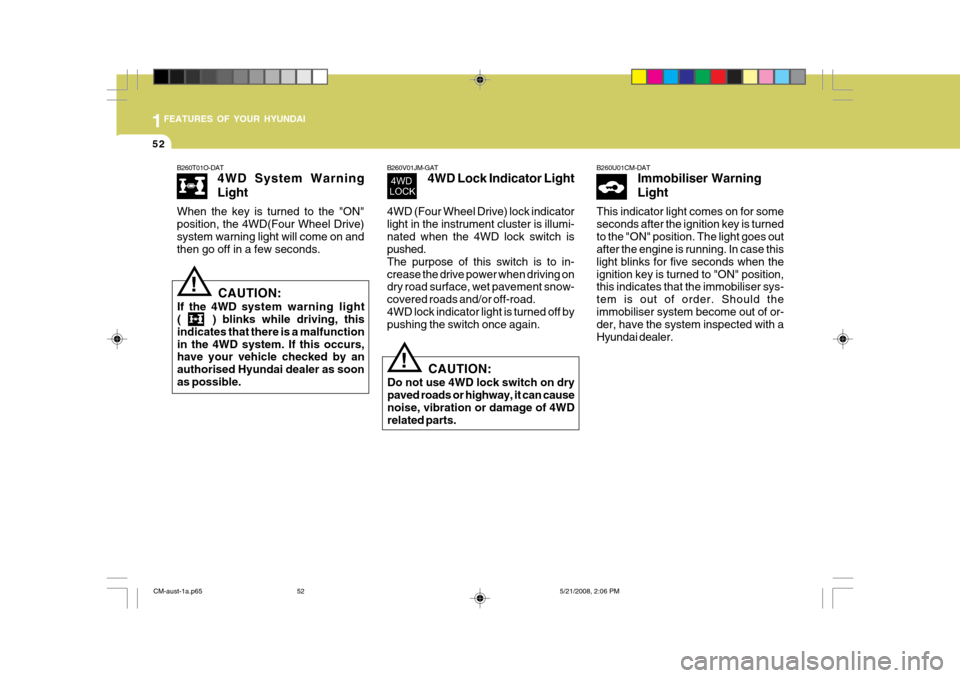
1FEATURES OF YOUR HYUNDAI
52
B260T01O-DAT 4WD System Warning Light
When the key is turned to the "ON" position, the 4WD(Four Wheel Drive)system warning light will come on and then go off in a few seconds.
CAUTION:
If the 4WD system warning light ( ) blinks while driving, this indicates that there is a malfunction in the 4WD system. If this occurs, have your vehicle checked by an authorised Hyundai dealer as soonas possible.! B260V01JM-GAT
4WD Lock Indicator Light
4WD (Four Wheel Drive) lock indicator light in the instrument cluster is illumi-nated when the 4WD lock switch is pushed. The purpose of this switch is to in-crease the drive power when driving on dry road surface, wet pavement snow- covered roads and/or off-road.4WD lock indicator light is turned off by pushing the switch once again.
CAUTION:
Do not use 4WD lock switch on dry paved roads or highway, it can cause noise, vibration or damage of 4WD related parts.
!
B260U01CM-DAT Immobiliser Warning Light
This indicator light comes on for some seconds after the ignition key is turnedto the "ON" position. The light goes out after the engine is running. In case this light blinks for five seconds when theignition key is turned to "ON" position, this indicates that the immobiliser sys- tem is out of order. Should theimmobiliser system become out of or- der, have the system inspected with a Hyundai dealer.
CM-aust-1a.p65 5/21/2008, 2:06 PM
52
Page 154 of 269
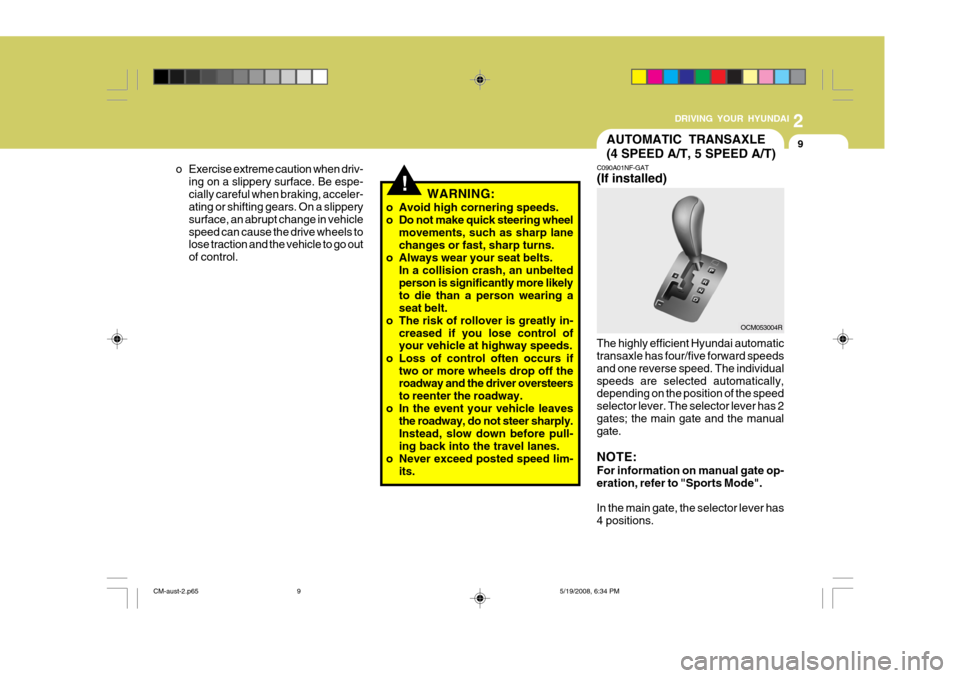
2
DRIVING YOUR HYUNDAI
9
!
o Exercise extreme caution when driv-
ing on a slippery surface. Be espe- cially careful when braking, acceler- ating or shifting gears. On a slippery surface, an abrupt change in vehiclespeed can cause the drive wheels to lose traction and the vehicle to go out of control. WARNING:
o Avoid high cornering speeds.
o Do not make quick steering wheel movements, such as sharp lanechanges or fast, sharp turns.
o Always wear your seat belts.
In a collision crash, an unbelted person is significantly more likely to die than a person wearing aseat belt.
o The risk of rollover is greatly in- creased if you lose control of your vehicle at highway speeds.
o Loss of control often occurs if two or more wheels drop off theroadway and the driver oversteers to reenter the roadway.
o In the event your vehicle leaves
the roadway, do not steer sharply.Instead, slow down before pull- ing back into the travel lanes.
o Never exceed posted speed lim- its.
AUTOMATIC TRANSAXLE (4 SPEED A/T, 5 SPEED A/T)
C090A01NF-GAT (If installed)
The highly efficient Hyundai automatic transaxle has four/five forward speeds and one reverse speed. The individualspeeds are selected automatically, depending on the position of the speed selector lever. The selector lever has 2gates; the main gate and the manual gate. NOTE: For information on manual gate op- eration, refer to "Sports Mode". In the main gate, the selector lever has 4 positions.
OCM053004R
CM-aust-2.p65 5/19/2008, 6:34 PM
9
Page 163 of 269
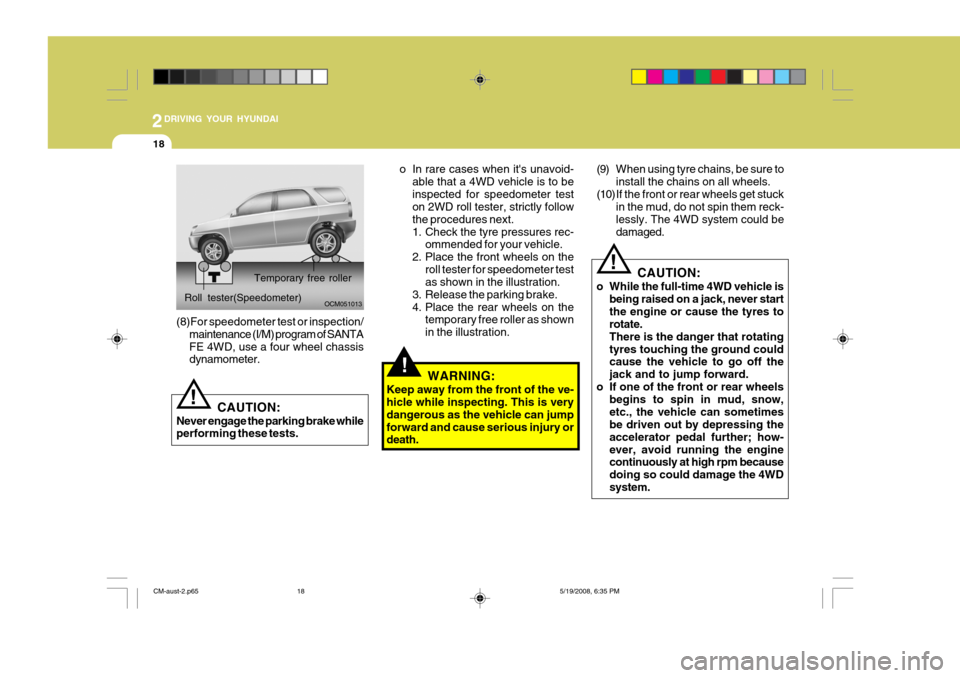
2DRIVING YOUR HYUNDAI
18
!
(9) When using tyre chains, be sure to
install the chains on all wheels.
(10) If the front or rear wheels get stuck
in the mud, do not spin them reck- lessly. The 4WD system could bedamaged.
CAUTION:
o While the full-time 4WD vehicle is being raised on a jack, never startthe engine or cause the tyres torotate.There is the danger that rotatingtyres touching the ground could cause the vehicle to go off the jack and to jump forward.
o If one of the front or rear wheels begins to spin in mud, snow,etc., the vehicle can sometimes be driven out by depressing the accelerator pedal further; how-ever, avoid running the engine continuously at high rpm because doing so could damage the 4WDsystem.
!
WARNING:
Keep away from the front of the ve- hicle while inspecting. This is very dangerous as the vehicle can jumpforward and cause serious injury or death. o In rare cases when it's unavoid-
able that a 4WD vehicle is to be inspected for speedometer test on 2WD roll tester, strictly follow the procedures next.
1. Check the tyre pressures rec-ommended for your vehicle.
2. Place the front wheels on the
roll tester for speedometer test as shown in the illustration.
3. Release the parking brake.
4. Place the rear wheels on the temporary free roller as shownin the illustration.
Roll tester(Speedometer)
(8)For speedometer test or inspection/ maintenance (I/M) program of SANTA FE 4WD, use a four wheel chassis dynamometer.
CAUTION:
Never engage the parking brake whileperforming these tests.
! OCM051013
Temporary free roller
CM-aust-2.p65
5/19/2008, 6:35 PM
18
Page 188 of 269
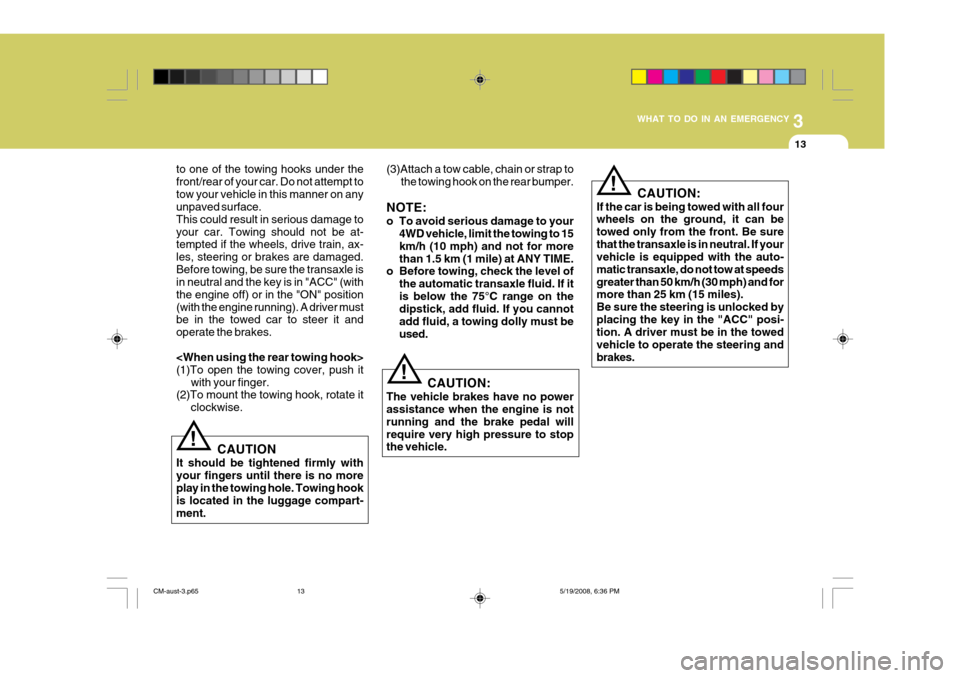
3
WHAT TO DO IN AN EMERGENCY
13
to one of the towing hooks under the front/rear of your car. Do not attempt totow your vehicle in this manner on any unpaved surface. This could result in serious damage toyour car. Towing should not be at- tempted if the wheels, drive train, ax- les, steering or brakes are damaged.Before towing, be sure the transaxle is in neutral and the key is in "ACC" (with the engine off) or in the "ON" position(with the engine running). A driver must be in the towed car to steer it and operate the brakes.
(2)To mount the towing hook, rotate it
clockwise. (3)Attach a tow cable, chain or strap to
the towing hook on the rear bumper.
NOTE:
o To avoid serious damage to your 4WD vehicle, limit the towing to 15 km/h (10 mph) and not for morethan 1.5 km (1 mile) at ANY TIME.
o Before towing, check the level of
the automatic transaxle fluid. If itis below the 75°C range on the dipstick, add fluid. If you cannot add fluid, a towing dolly must beused.
!
! CAUTION
It should be tightened firmly with your fingers until there is no more play in the towing hole. Towing hook is located in the luggage compart-ment. CAUTION:
If the car is being towed with all four wheels on the ground, it can be towed only from the front. Be surethat the transaxle is in neutral. If your vehicle is equipped with the auto- matic transaxle, do not tow at speedsgreater than 50 km/h (30 mph) and for more than 25 km (15 miles). Be sure the steering is unlocked byplacing the key in the "ACC" posi- tion. A driver must be in the towed vehicle to operate the steering andbrakes.
! CAUTION:
The vehicle brakes have no power assistance when the engine is not running and the brake pedal willrequire very high pressure to stop the vehicle.
CM-aust-3.p65 5/19/2008, 6:36 PM
13
Page 256 of 269
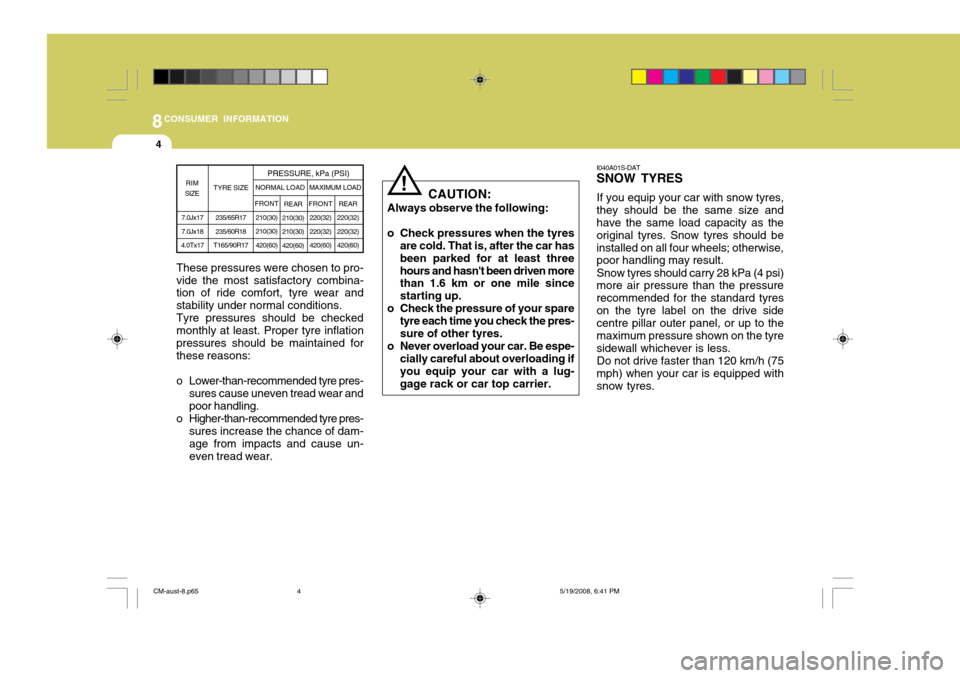
8CONSUMER INFORMATION
4
!
CAUTION:
Always observe the following:
o Check pressures when the tyres are cold. That is, after the car has been parked for at least threehours and hasn't been driven more than 1.6 km or one mile since starting up.
o Check the pressure of your spare tyre each time you check the pres-sure of other tyres.
o Never overload your car. Be espe- cially careful about overloading if you equip your car with a lug- gage rack or car top carrier. I040A01S-DAT
SNOW TYRES
If you equip your car with snow tyres,
they should be the same size and have the same load capacity as the original tyres. Snow tyres should beinstalled on all four wheels; otherwise, poor handling may result.
Snow tyres should carry 28 kPa (4 psi)
more air pressure than the pressure recommended for the standard tyreson the tyre label on the drive side centre pillar outer panel, or up to the maximum pressure shown on the tyresidewall whichever is less.
Do not drive faster than 120 km/h (75
mph) when your car is equipped withsnow tyres.
These pressures were chosen to pro-vide the most satisfactory combina- tion of ride comfort, tyre wear and stability under normal conditions.Tyre pressures should be checkedmonthly at least. Proper tyre inflationpressures should be maintained for these reasons:
o Lower-than-recommended tyre pres-
sures cause uneven tread wear and poor handling.
o Higher-than-recommended tyre pres-
sures increase the chance of dam- age from impacts and cause un- even tread wear.
7.0Jx17 7.0Jx18
4.0Tx17 TYRE SIZE
RIM
SIZE PRESSURE, kPa (PSI)
235/65R17235/60R18
T165/90R17 REAR
210(30)210(30)420(60) FRONT
220(32)220(32) 420(60)
NORMAL LOAD
MAXIMUM LOAD
REAR
220(32) 220(32) 420(60)
FRONT
210(30) 210(30)420(60)
CM-aust-8.p65 5/19/2008, 6:41 PM
4
Page 258 of 269
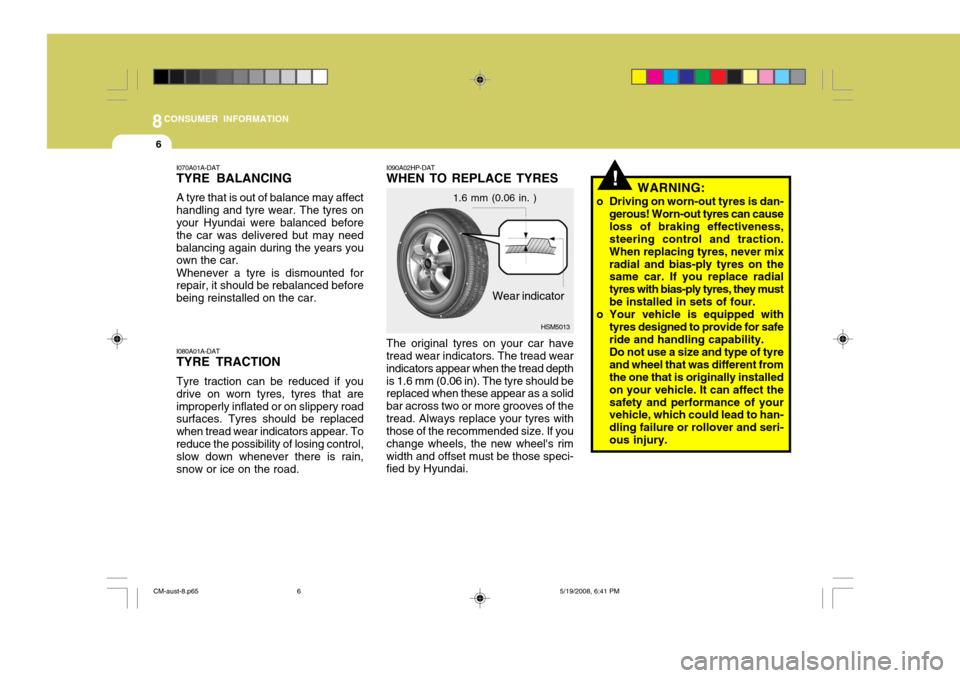
8CONSUMER INFORMATION
6
!
I090A02HP-DAT WHEN TO REPLACE TYRES The original tyres on your car have tread wear indicators. The tread wear indicators appear when the tread depthis 1.6 mm (0.06 in). The tyre should be replaced when these appear as a solid bar across two or more grooves of thetread. Always replace your tyres with those of the recommended size. If you change wheels, the new wheel's rimwidth and offset must be those speci- fied by Hyundai.
Wear indicator
1.6 mm (0.06 in. )
HSM5013 WARNING:
o Driving on worn-out tyres is dan- gerous! Worn-out tyres can cause loss of braking effectiveness, steering control and traction. When replacing tyres, never mixradial and bias-ply tyres on the same car. If you replace radial tyres with bias-ply tyres, they mustbe installed in sets of four.
o Your vehicle is equipped with tyres designed to provide for safe ride and handling capability. Do not use a size and type of tyre and wheel that was different from the one that is originally installed on your vehicle. It can affect thesafety and performance of your vehicle, which could lead to han- dling failure or rollover and seri-ous injury.
I070A01A-DAT TYRE BALANCING A tyre that is out of balance may affect handling and tyre wear. The tyres on your Hyundai were balanced before the car was delivered but may needbalancing again during the years you own the car. Whenever a tyre is dismounted for repair, it should be rebalanced before being reinstalled on the car. I080A01A-DAT TYRE TRACTION Tyre traction can be reduced if you drive on worn tyres, tyres that areimproperly inflated or on slippery road surfaces. Tyres should be replaced when tread wear indicators appear. Toreduce the possibility of losing control, slow down whenever there is rain, snow or ice on the road.
CM-aust-8.p65
5/19/2008, 6:41 PM
6
Page 259 of 269
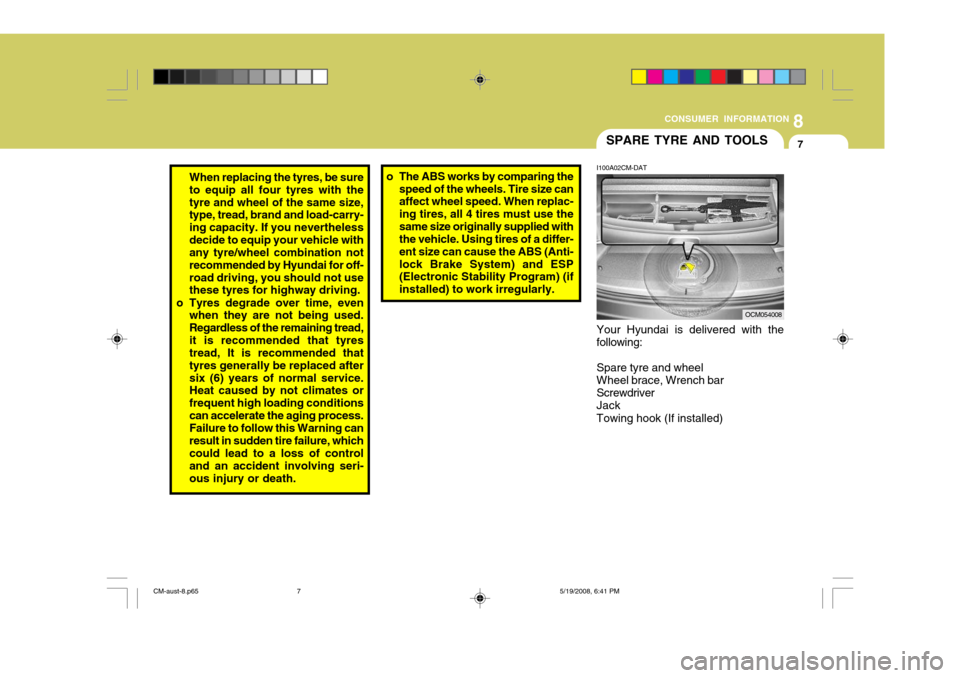
8
CONSUMER INFORMATION
7SPARE TYRE AND TOOLS
I100A02CM-DAT Your Hyundai is delivered with the following: Spare tyre and wheel Wheel brace, Wrench bar Screwdriver Jack Towing hook (If installed)
When replacing the tyres, be sure to equip all four tyres with thetyre and wheel of the same size, type, tread, brand and load-carry- ing capacity. If you neverthelessdecide to equip your vehicle with any tyre/wheel combination not recommended by Hyundai for off-road driving, you should not use these tyres for highway driving.
o Tyres degrade over time, even when they are not being used. Regardless of the remaining tread,it is recommended that tyres tread, It is recommended that tyres generally be replaced aftersix (6) years of normal service. Heat caused by not climates or frequent high loading conditionscan accelerate the aging process.Failure to follow this Warning canresult in sudden tire failure, which could lead to a loss of control and an accident involving seri-ous injury or death.
OCM054008
o The ABS works by comparing the
speed of the wheels. Tire size can affect wheel speed. When replac- ing tires, all 4 tires must use thesame size originally supplied with the vehicle. Using tires of a differ- ent size can cause the ABS (Anti-lock Brake System) and ESP (Electronic Stability Program) (if installed) to work irregularly.
CM-aust-8.p65 5/19/2008, 6:41 PM
7